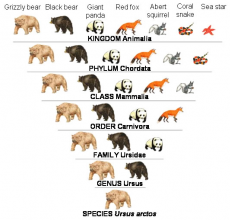

A reminder: classification is the act of organising organisms into categories based on similarities and differences, taking into account the way something looks, its genes, its behaviour and more. The Binomial Naming System is used in classification to name species. The naming of organisms is called ‘nomenclature’ where organisms are given a name that consists of two parts. With each internationally accepted scientific name given to an organism in Latin, it must be written in a certain way. The first name is the genus (remember this is the seventh level in the taxonomic hierarchy). The first letter of the genus must be a capital letter. The second part of the name is the species (the level in the hierarchy beneath genus). The species is written in lower case letters. All scientific names for organisms must be written in italics, however when handwritten, you should underline the word as it is difficult to see italics in handwriting. Us humans have the name Homo sapiens. Our genus is ‘Homo’ and our species is ‘sapiens.’ The binomial system is useful as we do not want any confusion through using common names.
Phylogeny is used to help us understand the evolutionary history of organisms. It will tell us which organisms are related and how closely related they are. This is due to the fact that all organisms have evolved from a common ancestor, which can be demonstrated on a phylogenetic tree (as shown in the diagram). The first branch is the beginning point where the shared common ancestor is. As new branches form, these are called diverging points. Diverging points are where organisms evolve to the extent where they are a different species. The phylogenetic species concept defines a species as ‘the smallest group that shares a common ancestor.’ If a species is closely related to another species, their diverging points will be closer together. Closer diverging points means less time for changes to occur. For example, humans and chimpanzees are closely related as our diverging points were more recent than when orangutans diverged. Believe it or not chimpanzees are more closely related to humans than to orangutans! Phylogeny is taken into consideration in classification, classifying organisms this way is termed ‘cladistics.’
Just because two organisms have similar traits, it does not make them closely related. A whale and a shark may look rather similar, but they are very different! They are two different species, the shark being a cartilaginous fish and the whale a mammal. The reason for them looking rather similar is due to their role in the environment or ‘ecological niches.’ Both have to swim and so a streamlined body with fins is necessary. Early classification systems used to focus on observational traits but we can see why this is problematic. If we were to base classification on observable traits alone, we would be wrongly placing all sorts of organisms. This is an example of convergent evolution. Convergent evolution is where organisms that are not closely related independently evolve similar traits to adapt to a similar environment, making them appear similar. Divergent evolution is the opposite, two organisms are closely related but their environments differ and so do their physical characteristics.
image -http://www.goldiesroom.org/Note%20Packets/02%20Classification/00%20Classification%20Packet--WHOLE.htm

0 Comment:
Be the first one to comment on this article.